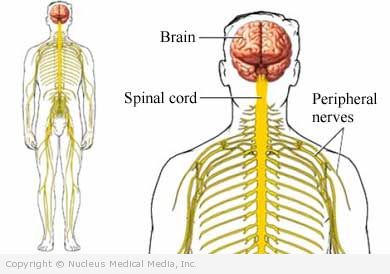Amyotrophic Lateral Sclerosis
(ALS; Lou Gehrig’s Disease; Motor Neuron Disease)
Amyotrophic Lateral Sclerosis – Definition
Amyotrophic lateral sclerosis (ALS) is a progressive nervous system disorder. It gradually destroys the nerves responsible for muscle movement. Over time, ALS leads to almost total paralysis of muscle movement, including breathing.
Prognosis is poor in most cases because of the progressive nature of the condition that eventually leads to respiratory failure. After diagnosis is made, life span ranges from 2-5 years. The five-year survival rate ranges from 14%-25%. Up to 10% of patients will survive more than 10 years. In general, the younger the age of onset, the slower the disease progresses.
Amyotrophic Lateral Sclerosis – Causes
The cause of ALS is not known. In a small number of cases, it appears that genes may have played a role. Also, research has shown that there may be a reduced response to cell stress and cell toxicity, The reduced response may be due to a build-up of certain protein in the brain.
Amyotrophic Lateral Sclerosis – Risk Factors
A risk factor is something that increases your chance of getting a disease or condition. Risk factors include:
- Having a family member with ALS
- Being in the military or having other occupations with risk of exposure
- Having certain genetic mutations
Amyotrophic Lateral Sclerosis – Symptoms
Symptoms of ALS include:
- Progressive weakness in arms and legs (at first often on only one side) over weeks to months without changes in sensory abilities.
- Initial presentation may be a wrist or foot drop
- Trouble holding things without dropping them
- Frequent tripping while walking
- Shrunken muscles
- Twitchy muscles
- Unpredictable changing emotions
- Clumsiness
- Overactive reflexes
- Slurred speech
- Hoarseness
- Trouble chewing and swallowing, resulting in frequent choking and gagging
- Weight loss due to trouble eating
- Trouble breathing
- Excess salivation, drooling
- Cognition is intact
- Sensation is intact
- Trouble coughing, resulting in development of pneumonia
Amyotrophic Lateral Sclerosis – Diagnosis
The doctor will ask about your symptoms and medical history. A physical exam may be done. There are no tests that definitively diagnose ALS.
Tests may be used to rule out other medical conditions. These tests may include:
- Electromyogram (EMG) /nerve conduction velocities (NCV) — to evaluate the muscles and the nerves
- CT Scan — a type of x-ray that uses a computer to make pictures of the structures inside the head and spine
- MRI Scan — a test that uses magnetic waves to make pictures of the structures inside the head and spine
- Blood tests — to rule out metabolic, heavy metal exposure, or rarely infections (eg, Lyme disease, HIV, human T-lymphotropic virus [HTLV])
- Lumbar puncture — a procedure to collect cerebrospinal fluid (CSF)
- Urine tests
Amyotrophic Lateral Sclerosis – Treatment
There is currently no cure for ALS.
Some treatment may help to reduce or manage symptoms for a time. For you and your family, a multidisciplinary approach may work best. This approach may include:
- Taking medicines
- Working with therapists and joining a support group
- Participating in religious and social activities
Treatments options include:
Medications
The drug riluzole has been approved for ALS. Clinical trials reveal a modest lengthening of survival. The drug may slightly improve functioning, but it does not stop the disease from progressing. Other drugs are also being studied.
Your doctor may prescribe these medicines for symptoms
- Diazepam (eg, Valium), baclofen (eg, Lioresal), or dantrolene —to reduce spasticity
- Nonsteroidal anti-inflammatory drugs (NSAIDs) and other pain medicines
- Atropine (eg, AtroPen), scopolamine (eg, Isopto), botulinum toxin (eg, Botox), antihistamine — to reduce heavy drooling
- Antidepressants and anti-anxiety medicines
- A combination of dextromethorphan and quinidine — to treat inappropriate laughter or crying
Other Types of Treatments
Supportive care may be needed as ALS progresses including:
- Physical therapy — to reduce pain associated with muscle cramping and spasticity.
- Respiratory care — In some cases, you may need to receive a mixture of air and oxygen from a machine. If you cannot move enough air in and out of your lungs, you may need surgery to have a tube inserted into your airway.
- Nutritional care — Your doctor may make changes to your diet. In some cases, getting nutrition through tube feeding is needed.
- Speech therapy — Speech therapy may be used to optimize communication. Therapy can include exploring alternative methods of communication.
Amyotrophic Lateral Sclerosis – Prevention
There are no guidelines for preventing ALS because the cause is unknown.

